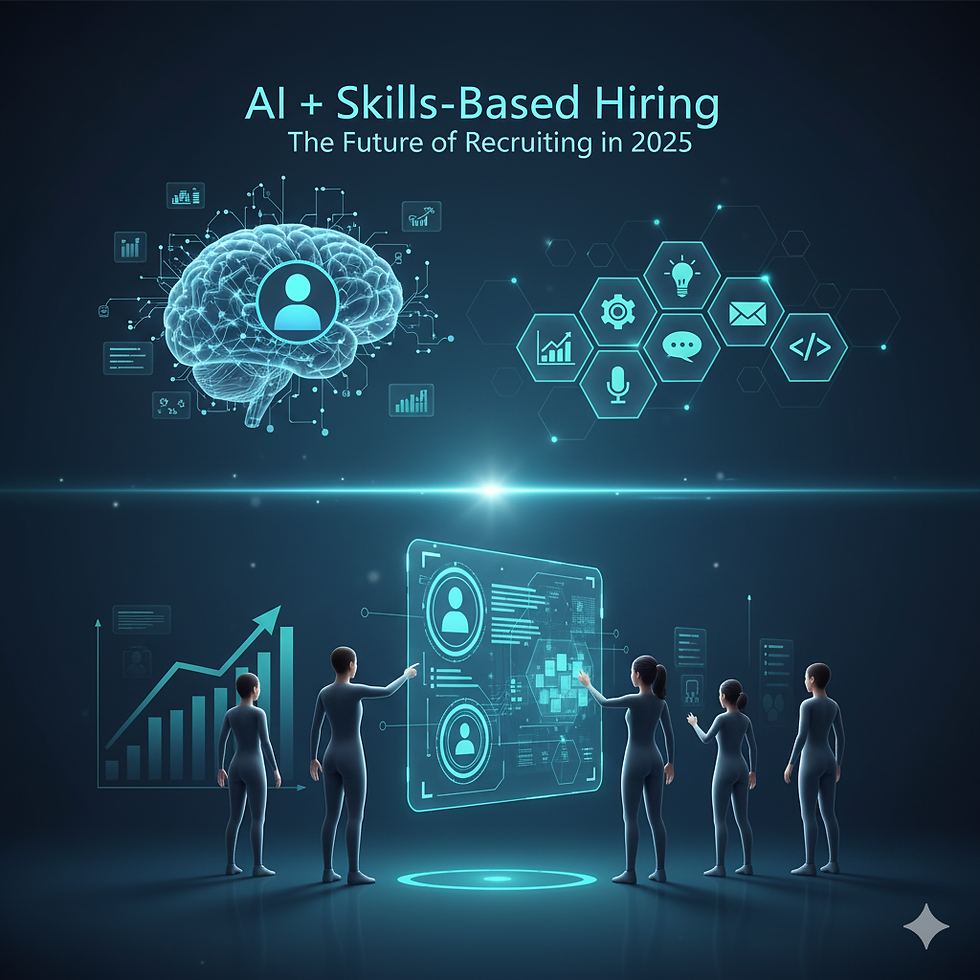Flat-Fee Recruiting for Data Science & Machine Learning Roles: Fast, Transparent, and Cost-Effective in 2025
- Saman Nayab
- Aug 12
- 4 min read

Data Science and Machine Learning (ML) roles remain some of the most in-demand positions in the global job market. From predictive analytics in healthcare to AI-powered recommendation engines in e-commerce, businesses rely on these professionals to transform raw data into actionable insights and intelligent systems.
But here’s the challenge: hiring top-tier data talent isn’t easy — the competition is fierce, and salaries can be steep. Traditional recruitment models, especially commission-based ones, often add even more cost and uncertainty to the process. That’s where flat-fee recruiting comes in — offering a transparent, predictable, and efficient way to hire.
What is Flat-Fee Recruiting?
Flat-fee recruiting is exactly what it sounds like — instead of paying recruiters a percentage of a hire’s annual salary (which can easily be 20–30% for high-paying data science roles), you pay a fixed, pre-agreed fee for the entire recruitment process.
This model benefits companies in several ways:
Predictable Costs – No surprises when the candidate’s salary is finalized.
Faster Time-to-Hire – Recruiters are incentivized to fill the role efficiently without prolonging negotiations for a higher commission.
Better Alignment – The focus is on finding the right candidate, not just the highest-paid one.
Why It Works for Data Science & ML Roles
Data science roles require more than just technical skill — they demand business understanding, problem-solving ability, and often, strong communication skills. Flat-fee recruiting allows hiring managers to invest more in assessment and candidate quality instead of overpaying recruiter commissions.
Key advantages for data and ML hiring:
Access to Specialized Talent Pools – Flat-fee recruiters often build niche databases of data scientists, ML engineers, and AI specialists.
Skills-Based Shortlisting – Many flat-fee recruiters use assessments for Python, R, SQL, TensorFlow, PyTorch, and statistical modeling.
Cost Efficiency for High Salaries – On a $150K salary, a 25% commission is $37,500. A flat fee (e.g., $5K–$8K) is dramatically lower.
In 2025, the trend is moving away from simply checking degrees and years of experience. The most effective hiring focuses on demonstrated capability.
Core competencies recruiters assess include:
Programming: Python, R, SQL, Java.
Machine Learning: Model building, feature engineering, algorithm optimization.
Data Visualization: Tools like Tableau, Power BI, or D3.js.
Big Data Tools: Spark, Hadoop, AWS, GCP.
Mathematics & Statistics: Probability, hypothesis testing, regression analysis.
Soft Skills: Communication, stakeholder management, problem framing.
Flat-fee recruiters can integrate practical technical tests and case study assignments to validate these skills before presenting candidates.
The Flat-Fee Recruitment Process for Data Science & ML Roles
Here’s how a typical flat-fee process works:
Discovery & Role Profiling – Define tech stack, industry context, data challenges, and project goals.
Talent Sourcing – Tap into curated networks, LinkedIn searches, and niche job boards like Kaggle Jobs.
Skills Assessment – Customized coding and ML challenges relevant to the company’s real-world data problems.
Shortlisting – Only candidates who pass technical and cultural fit checks move forward.
Interview Coordination – Streamlining scheduling between busy hiring managers and in-demand candidates.
Offer Management – Ensuring quick decision-making to avoid losing talent to competitors.
Trends in 2025 for Data Science & ML Recruiting
The hiring landscape in 2025 is shaped by several key shifts:
AI-Driven Candidate Matching – Recruiters are using machine learning to match candidates to jobs based on skill clusters, project experience, and career trajectory.
Remote & Hybrid Teams – More companies are open to fully remote data scientists, widening the global talent pool.
Micro-Specialization – Roles are becoming niche: e.g., NLP engineers, MLOps specialists, and AI ethics researchers.
Greater Emphasis on Business Impact – Companies want data scientists who can connect models to measurable ROI, not just accuracy metrics.
Faster Hiring Windows – Top candidates are often off the market in under 10 days — speed is essential.
Cost Comparison: Flat-Fee vs. Commission-Based
Let’s break it down with a real-world example:
Model | Base Salary | Recruitment Fee % | Total Cost |
Commission-Based (25%) | $150,000 | $37,500 | $37,500 |
Flat-Fee ($6,000) | $150,000 | N/A | $6,000 |
Savings: $31,500 per hire — which can be redirected into onboarding, training, or tech infrastructure.The ROI of Flat-Fee Recruiting in Sales Hiring
For sales roles, every week without the right hire can mean lost revenue opportunities. Flat-fee recruiting maximizes ROI by:
Reducing Time-to-Hire – Faster placements mean quicker revenue generation.
Lowering Acquisition Costs – A single fixed fee avoids escalating commission-based expenses.
Improving Quality of Hire – Skills-based screening ensures new hires can hit quotas faster.
Boosting Retention – Matching candidates to both role requirements and company culture reduces turnover costs.
When measured against the cost of prolonged vacancies or poor hires, flat-fee recruiting often delivers a positive ROI within the first few months of the new sales hire’s performance.
FAQs About Flat-Fee Recruiting for Data Science Roles
Q1: Is flat-fee recruiting only for entry-level roles? No. It’s used for all levels, including senior ML engineers and AI architects.
Q2: Does it compromise candidate quality?
Not if done properly. In fact, flat-fee recruiters often present more rigorously vetted candidates because they focus on fit over commission.
Q3: How long does the process take?
On average, 3–5 weeks, depending on role complexity and assessment stages.
Q4: Can it be used for contract hires? Yes. Many agencies offer flat-fee packages for both permanent and contract positions.
Conclusion
In 2025, companies can’t afford to waste time or money in the race for data talent. Flat-fee recruiting provides a faster, more transparent, and budget-friendly way to hire skilled Data Science and Machine Learning professionals — without sacrificing quality. By combining cost predictability with skills-based evaluation, businesses can secure the right people to drive their AI and analytics ambitions forward. Book a free consultation with Behoof today!




Comments